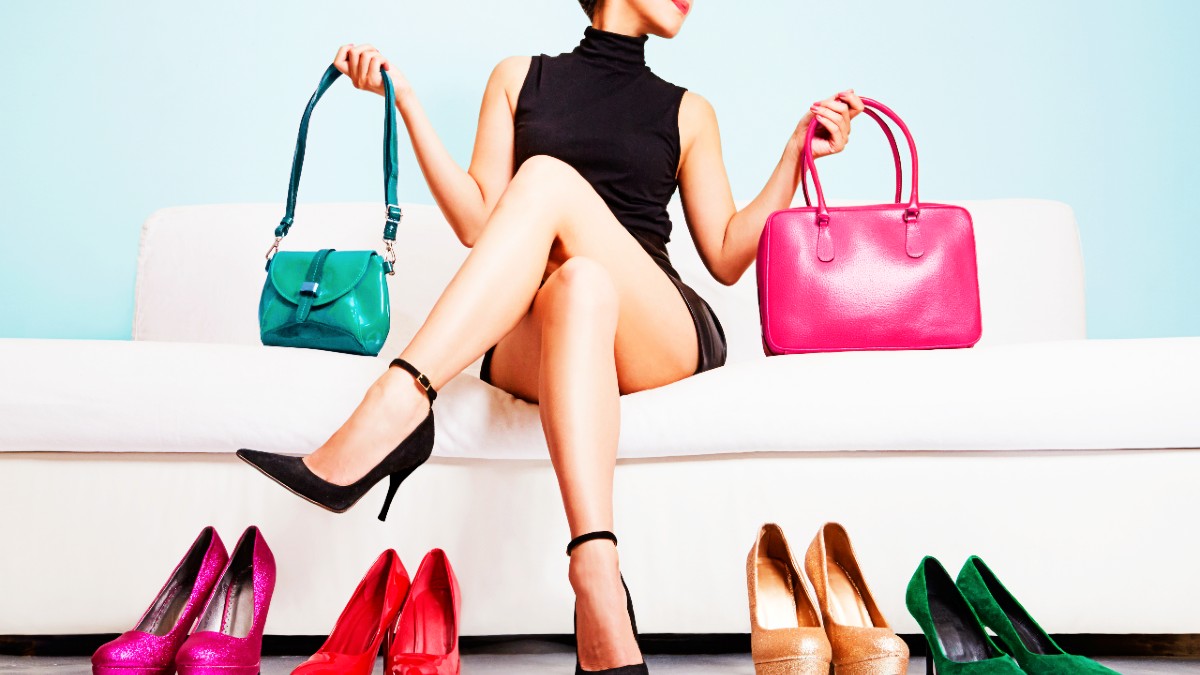Bored, rich and very demanding: Only the best will do for China’s cashed up post-COVID luxury machine

Do you have something in red? Via Getty
After three very ordinary years of hardcore COVID control policies, China’s doing the Big Reopen. And the first in line are the best dressed.
Cashed-up and luxury-starved, cross-border travel is on, pent up demand is fit to burst and the exciting re-emergence of the spendy-spend affluent Chinese consumer – global luxury’s most dynamic engine – is set to light a fire under demand.
Demand for what, exactly?
Everything unessential, glamorous and expensive. Morgan Stanley expects Chinese consumers to drive sales of luxury goods – high-end clothing, funny shoes, accessories and other such wonders – by an even 20% over the next 10 months.
“China should become the industry’s growth engine from this year on, and we expect brands at the top of the luxury-goods pyramid to benefit the most,” says Morgan Stanley equity analyst Edouard Aubin.
And they won’t be bargain hunting.
While Western consumers regard China as the home of the bargain basement, the opposite could not be more true for today’s upwardly mobile post-pandemic brand afficianado.
An example: According to data compiled last month by digital services provider Lectra, today a pair of luxury shoes in Shanghai (think Prada, Ferragamo… Dunlop), is going for a whole lot more than in other major foreign markets, including those most likely to foist money on class – Japan, the EU, the Poms and in the US.
Global luxury labels have “significantly higher price points in China for their men’s footwear offerings,” Lectra concluded.
in China, Louis Vuitton stuff goes for twice the price it would in Europe. Snazzy shoes by the Italian luxury name Ferragamo, and those by Prada, were 50% mark ups.
Growing supply line costs, the pandemic, global inflation and a surge in demand for luxury men’s footwear seen in the market have all driven prices higher.
And let’s recall this is not a sector in the doldrums.
Last year, the crap one, the value of the global personal luxury goods market hit somewhere above 350 billion euros.
Luxury goods – all the nonsense, from fashion, cosmetics, fragrances, watches, jewelry, luggage and handbags – has been on an upward climb and the pandemic only added fuel.
So the return of the dormant Chinese cohort is likely to account for 60% of total spending growth on personal luxury goods through 2030, Morgan Stanley estimates.
“China should become the industry’s growth engine from this year on, and we expect brands at the top of the luxury-goods pyramid to benefit the most,” says Mr Aubin.
Two Sessions: legislating for luxury
Last week, China wrapped up the National People’s Congress (NPC) and the Chinese National People’s Political Consultative Conference (CNPPC) – referred to unimaginatively as the Two Sessions – and considered China’s most important annual political events.
The upshot of the Two Sessions looks like a bunch of pro-local policies for global luxury brands. First cab off the rank will be a gargantuan subsidy program targeting Beijing’s retail competitiveness. Which is pretty ordinary compared to Shanghai.
The party’s decided that companies which choose Beijing as their first Asia retail opening will be eligible for as much as US$720,000 or 5 million yuan.
Similar insanely generous subsidies for incredibly well funded brands (which decide to make their mainland China debut in Beijing, or add a Beijing presence to their China operations) are on the table.
This madcap luxury train of free money actually left Beijing in November last year – after Xi’s big October plan to reopen got green lit. That’s when about US$300,000 (2.2 million yuan) in subsidies started getting thrown about for any and all silly fashion, beauty, jewellery, perfume and fiddly little accessories brands who choose to throw their promo events and new releases in the capital.
These are but a few among a vast swathe of new socialist measures with Chinese characteristics designed to supercharge domestic consumption.
Usually about here I’d point out that it’s not a great look for the Party to be spending so much on wealthy foreign luxury brands when the money could be used at home for more essential social projects, but it’s probably a good time to start practising.
Luxury houses can rest assured that the China market will certainly present new opportunities in 2023.
Back from the sidelines
Before the pandemic, two-thirds of Chinese consumers’ personal spending on luxury goods took place outside of China, and Chinese consumers accounted for about 60% of total industry growth between 2000 and 2019. Although these consumers remained the largest cohort for luxury spending in 2022, disruption from COVID sent their spending down between 10% and 15% last year, after a 20% year-over-year increase in 2021.
Stocks of luxury goods companies proved surprisingly resilient last year, as strong demand from high-income consumers and favourable exchange rates helped offset high inflation and rising borrowing costs.
And while valuations are back to historical averages, Aubin reckons China – the most important market for European luxury names – is driving more opportunity in the sector in the coming year and longer.
“Overall, we expect industry growth to remain solid this year at 7%, albeit slowing from around 15% in 2022, which should lift earnings per share for leading brands by at least 10%,” Aubin says.
In the rest of the world, analysts expect luxury spending in the Middle East to rise 15% in 2023, while South Korea and Japan register single-digit growth. Over in Europe and the states, spending is expected to fall by low single digits.
When in Rome… please go home
With the ability to resume overseas travel for the first time in three years, Chinese consumers can once again take advantage of cheaper prices in Europe, which can be as much as 30% lower than in China, depending on the brand.
The Chinese government has cut import duties and opened duty-free shopping centres in an attempt to repatriate luxury shoppers.
However, the delightful problem for luxury brands is that they’re too attractive for their own goods.
From our POV a big spending weekend stopover in Rome and laying out a bazillion euros for a few Chanel handbags would be a winner, right?
Well, not really. The siren song of bargain Dior and lower Louis V’s which currently abound around the EU (not to mention a little Euro-vaycay) isn’t super ideal for luxury brands.
Your average funny coloured handbag right now can go for almost a full third lower on the continent than in China and Honkers.
So if Chinese tourists spend the same amount but do it in Europe, this could suck the life out those spectacular margins, given what we know already about prices in China.
Before the pandemic
In 2019, Chinese shoppers accounted for 30 to 33% of luxury consumers; American consumers comprised 22%, and European 18%.
More recently, the surge by American and European shoppers in the past two years has taken some of the overall market share from Chinese consumers, however, with the lifting of lockdowns in China in the past few months, the expectation for 2023 “is a very strong rebound for Chinese luxury spending.
The rebound sparked by Chinese consumers is expected to extend into next year, which would be conducive to sustaining the above-average demand – double-digit percentage gains on average.
And growth potential?
Well. Louis Vuitton indicated in 2018 that it had 5 million Chinese consumers globally, representing .03 percent of the population in China.
Offsetting US decline
Another key theme for the luxury sector in 2023 is whether the pickup in Chinese demand will be enough to offset slowing spending in the West. Analysts expect US consumers to spend 1% less on luxury goods this year. It’s a small but important shift since sales among this group grew around 75% between 2019 and 2022, making the US the fastest-growing major nationality in this spending category during that period. In Europe, analysts expect a 3% decline in spending.
The so-called ultra-premiumisation of the luxury market may also skew regional shopping trends. Chinese and Korean shoppers are increasingly favouring brands with the highest price points, which they view as status symbols, while cutting spending on the less expensive, more fashion-oriented or “aspirational” brands favoured by Western shoppers.
Meanwhile, Chinese investment into foreign brands is often underpinned by a growth strategy that prioritises the scaling of the business in the China market, and while analysts don’t expect a rush to close more international deals, there are signs of a shifting their focus from pure luxury turnaround targets to accessible luxury acquisitions and Asian brands.
Possible Headwinds
While Morgan Stanley analysts are positive about the luxury sector for 2023, they remain on alert for potential surprises:
- The strong Chinese demand may be short-lived, the result of “revenge spending” as shoppers make up for time lost to the pandemic.
- Contraction of the Chinese housing market may have a negative effect on wealth.
- While Western buyers in higher income brackets have buoyed spending, a negative wealth effect and wage pressure on white-collar jobs could undermine that.
- Spending abroad by Chinese nationals could resume more slowly than expected over the next 18 months.
- If luxury goods are more expensive than consumers expect, they could buy fewer items overall.
- In the event of a global recession this year, luxury goods sales could decline further. During the 2008-2009 recession, luxury sales saw the biggest drops in the West and the US. Pressure on the US housing market in 2023 could result in weakness to the sector.
Nonetheless, says Aubin, “we believe luxury demand in China should pick up faster than feared and will be material enough to offset the reversal of recent years of record growth in the US.”
Related Topics
UNLOCK INSIGHTS
Discover the untold stories of emerging ASX stocks.
Daily news and expert analysis, it's free to subscribe.
By proceeding, you confirm you understand that we handle personal information in accordance with our Privacy Policy.








